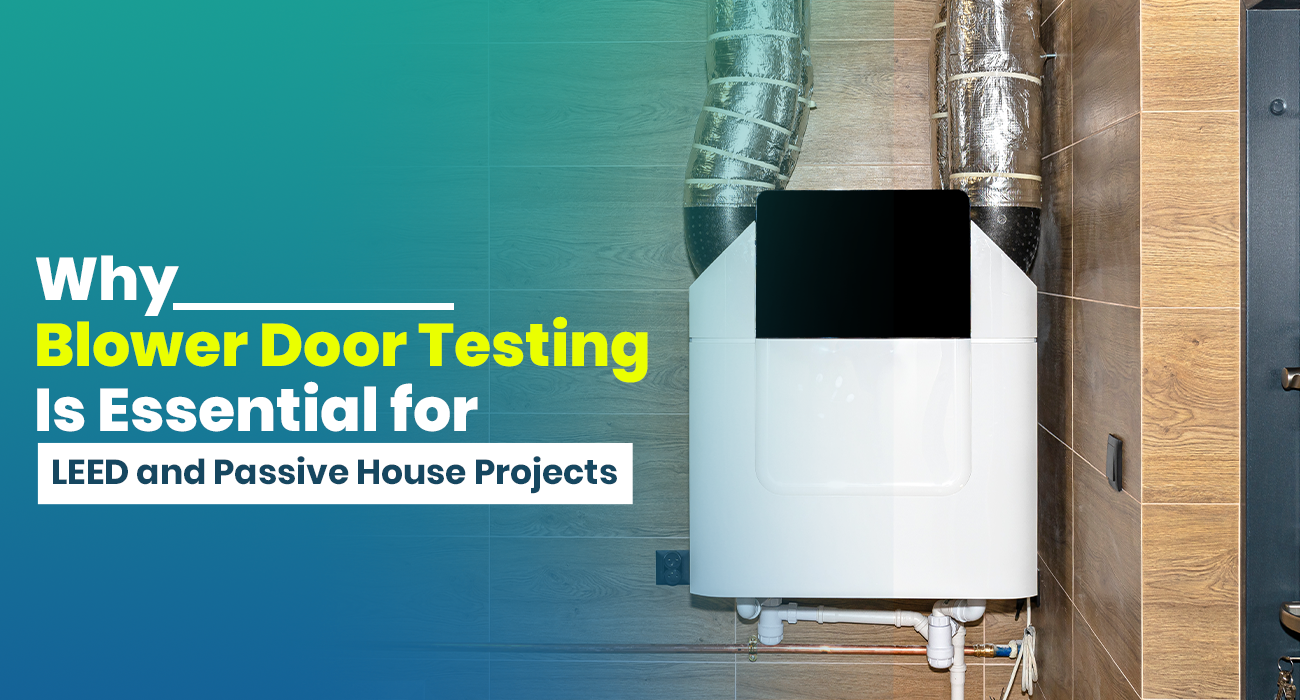
Why Blower Door Testing Is Essential for LEED and Passive House Projects
In today’s construction world, energy efficiency and airtightness are more than just buzzwords—they are measurable targets tied to global green building standards. One of the most reliable tools used to assess a building’s airtightness is blower door testing. This technique is not only an inspection method but a gateway to energy efficiency certification systems like LEED and Passive House.
This blog explains the importance, methodology, and application of blower door testing in detail, using the field-tested practices from experts like Cornerstone Middle East, known for delivering quality testing and inspection services in the region.
What is Blower Door Testing?
Blower door testing is a method to measure how much air leaks into or out of a building. The test uses a high-powered fan mounted in a temporary, airtight door. This fan pulls air out of the building to create a pressure difference between the inside and outside.
The equipment measures how quickly air flows through leaks, cracks, and openings in the building envelope. This helps in:
- Determining energy loss
- Improving heating and cooling efficiency
- Enhancing indoor air quality
- Meeting building code or certification requirements
For green building certifications like LEED and Passive House, blower door testing is a critical component of compliance and performance verification.
Why is Blower Door Testing Important for LEED Projects?
LEED (Leadership in Energy and Environmental Design) is a global rating system that promotes sustainable, energy-efficient building practices. Blower door testing is essential in LEED projects because it verifies that the building envelope meets the required air infiltration thresholds.
Here’s how blower door testing supports LEED:
- Supports Energy & Atmosphere Credits: Airtightness improves energy performance, which helps projects score points under the “Optimize Energy Performance” and “Fundamental Commissioning” categories.
- Ensures Building Envelope Quality: Testing confirms that construction practices align with design specs, especially regarding thermal insulation and air barriers.
- Reduces HVAC Loads: By limiting unwanted air exchange, the building requires less energy to heat or cool indoor spaces.
- Facilitates Envelope Commissioning: LEED v4 recommends envelope commissioning as a way to ensure building performance goals are met; blower door testing is a part of that process.
Blower Door Testing Requirements in Passive House Design
Passive House (or Passivhaus) is one of the most stringent energy efficiency standards worldwide. It demands extremely low air leakage rates to maintain controlled ventilation and reduce heating and cooling loads.
The air change rate limit for Passive House buildings is:
- 0.6 air changes per hour at 50 Pascals (ACH50)
This is measured during blower door testing and is a non-negotiable requirement for certification.
Benefits in Passive House context:
- Maintains Thermal Comfort: Reduced drafts lead to more stable indoor temperatures.
- Lowers Energy Use: Enhanced airtightness significantly reduces the need for heating and cooling.
- Improves Durability: By controlling where air and moisture enter, long-term damage from condensation and mold is reduced.
- Supports Mechanical Ventilation Systems: Balanced ventilation systems like HRVs or ERVs work best when the envelope is airtight.
Technical Process of Blower Door Testing
Blower door testing involves specific technical steps to ensure accurate results. Here is the full testing sequence:
- Preparation Phase
- All windows and exterior doors are closed.
- Interior doors are opened for airflow balance.
- Combustion appliances are shut off or isolated.
- Vents, flues, and ducts are sealed.
- Equipment Installation
- A temporary blower door frame is mounted in an exterior doorway.
- A calibrated fan and pressure sensors are installed.
- Measurement equipment connects to digital gauges or software for live data capture.
- Baseline Pressure Measurement
- Initial readings are taken to record indoor-outdoor pressure differentials.
- Depressurization Testing
- The fan depressurizes the building to 50 Pascals.
- As air flows in through leaks, the system records the airflow rate required to maintain that pressure.
- Leak Detection & Diagnostics
- Technicians may use:
- Smoke pens or tracer gas
- Infrared thermography (thermal imaging cameras)
- Ultrasonic detectors
- These tools pinpoint exact leak locations in the building envelope.
- Technicians may use:
- Data Analysis
- The key metric is ACH50 (Air Changes per Hour at 50 Pascals).
- This is calculated using the building’s volume and fan flow data.
- Reporting & Recommendations
- A detailed report includes air leakage rate, compliance results, and suggested corrective actions if needed.
Common Problems Detected During Blower Door Testing
Blower door testing often uncovers unseen issues that can compromise a building’s energy performance. Here are frequent culprits:
- Poor sealing around doors and windows
- Gaps around electrical outlets and switch plates
- Leaks through plumbing penetrations or recessed lighting
- Air leakage from attic hatches or basement rim joists
- Inadequate duct sealing in HVAC systems
Fixing these problems early ensures that a project doesn’t fail at the certification stage and avoids costly retrofits.
How to Prepare for Blower Door Testing During Construction
To avoid last-minute surprises and failed tests, building teams should adopt airtightness practices early:
- Design for Airtightness: Plan detailing around penetrations, joints, and transitions.
- Use Continuous Air Barriers: Materials must be compatible and installed correctly across the entire envelope.
- Schedule Mid-Construction Testing: This allows leaks to be found and fixed before insulation and drywall are installed.
- Train Construction Teams: Ensure that subcontractors understand how their work impacts airtightness.
In complex projects, involving experienced commissioning firms like Cornerstone Middle East helps streamline compliance and reduce the chance of failure.
Conclusion: Why Blower Door Testing Is a Non-Negotiable Step
In modern sustainable construction, blower door testing is more than just a tool—it’s an essential process that validates energy performance, identifies envelope weaknesses, and ensures buildings meet green building standards.
For LEED and Passive House projects, blower door testing plays a direct role in achieving certification. It helps confirm that airtightness levels are not only designed but actually delivered in the final building. The results influence everything from HVAC system sizing to occupant comfort and long-term operational costs.
By partnering with skilled inspection providers like Cornerstone Middle East, builders and developers can ensure accurate testing, expert reporting, and actionable insights. In an era of rising energy costs and sustainability goals, blower door testing is not just best practice—it’s a requirement for quality and performance.





Post a comment